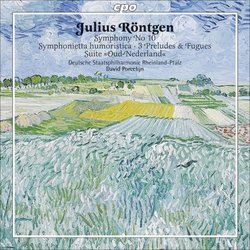| All Artists: Rontgen, Porcelijn, Deutsche Staatsphilharmonie Title: Julius Röntgen: Symphonietta humoristica Members Wishing: 0 Total Copies: 0 Label: Cpo Records Original Release Date: 1/1/2008 Re-Release Date: 8/26/2008 Genres: Dance & Electronic, Classical Style: Symphonies Number of Discs: 1 SwapaCD Credits: 1 UPC: 761203730827 |
Search - Rontgen, Porcelijn, Deutsche Staatsphilharmonie :: Julius Röntgen: Symphonietta humoristica
 | Rontgen, Porcelijn, Deutsche Staatsphilharmonie Julius Röntgen: Symphonietta humoristica Genres: Dance & Electronic, Classical |
Larger Image |
CD Details |
CD ReviewsAbsolutely First-Rate and Delightful Music from a Dutch Mast J Scott Morrison | Middlebury VT, USA | 09/24/2008 (5 out of 5 stars) "As I said in an earlier review Julius Röntgen: Symphony No. 3; Suite "Aus Jotunheim", 'It is a mystery to me why the music of Julius Röntgen (1855-1932) isn't better known and more frequently played.' Indeed, discovering some of his music has been one of my greatest delights in the last couple of years. That earlier release is now followed by a CD containing two symphonies, a set of preludes and fugues, and a suite on old Dutch folk music.
Röntgen's Symphony No. 10, the so-called 'Waltz Symphony', from 1930, is a short -- ten minutes -- one-movement work which was described by him as full of 'mirthfulness', and that it is. After an excitable, almost Mendelssohnian introduction, we are carried off into a world of 3/4-time geniality. These are not Viennese waltzes, but rather more peasant-like dances that exude the joy of living. As usual, Röntgen's orchestration is a pleasure to hear. The 'Symphonietta humoristica' (1922) is a four-movement, seventeen-minute work that begins with wildly humorous four-horn fanfaronade -- shades of the horns in Rosenkavalier -- leading into a high--spirited 'vivace giocoso' first movement. The 'con moto e con delicatezza' second movement combines a lightly-scored music-box of pizzicato high strings and chirping flutes and piccolo with lyrical passages for full orchestra. The third movement features droning bourdon basses and sprightly wind melodies surround by garlands of string figuration. The finale has pizzicato basses, melodic bassoon, whirling high winds in fourths, all in support of a lyrical violin melody alternating with furiously rushing pizzicato string section posed against chorale brass. There is not a serious or anguished moment in this aptly named 'humorous symphony.' Indeed, it occurs to me that Röntgen was much better at conveying high spirits, optimism and gemütlichheit than darker moods. The Three Preludes and Fugues (1918) are all based on the same motif - G B G Bflat F - (G H G B F in German notation), notes taken from the name of a friend and admirer Gerhard G. von Brucken Fock. Not only are the fugues masterfully done (and with a clever variation of construction that this rather awkward motif would not naturally suggest) but the preludes are exemplars of advanced early twentieth-century harmony and orchestration, worthy of study by composition students even today. Delightful. The 'Old Netherlands Suite' is a symphony in all by name. It consists of four movements lasting 18 minutes. They have Dutch titles which I have been unable to translate except for the third 'Contredans' which simply means 'Contradance.' The first, 'Janne moeie, al clear, al clear!', is a rustic-sounding 4/4 with its share of foot-stomping and hunting horns. The second, 'Niet dan druk en lijden & is in't herte mijn', is a slow, lyrically beautiful love song gorgeously orchestrated with lush horn chords and full strings. 'Contredans' is a lively 2/4 dance in which one can imagine gentleman whirling their partners as they kick up their heels. The middle section sounds courtly, but ironically so. The finale, 'Heer Halewijn zong een Liedekijn', we're told by the booklet notes, is about a Dutch variant of the Bluebeard story in which the womanizing Duke is decapitated by a princess. Nothing that violent is heard in the music, however; rather, it expresses noble sentiments throughout. On the basis of this and the previously reviewed CD, I'm prepared to say that the Deutsche Staatsphilharmonie Rheinland-Pfalz under conductor David Porcelijn are superb purveyors of Röntgen's brilliant orchestral works and I am eager to hear more from them. Strongly recommended. Scott Morrison" |
